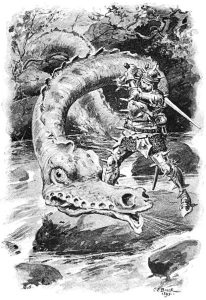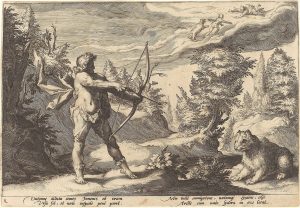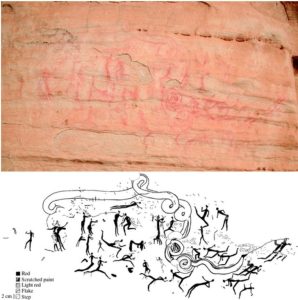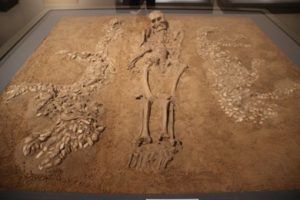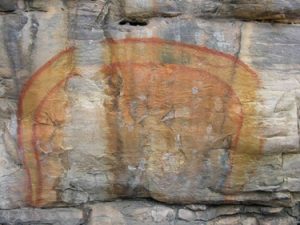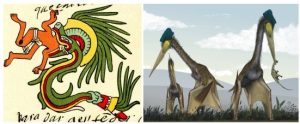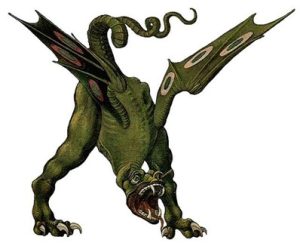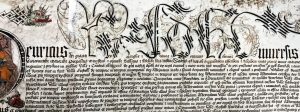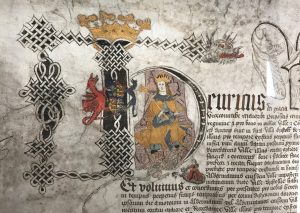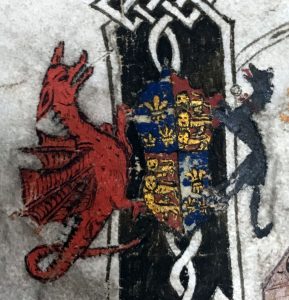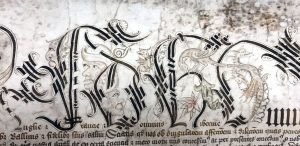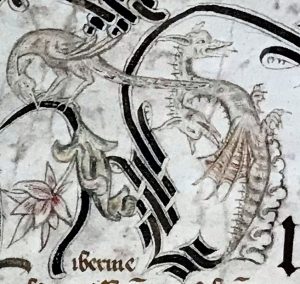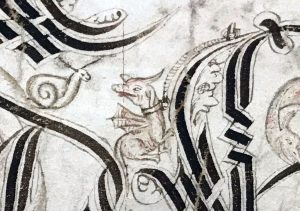Four previous posts on this blog have already dabbled in the fascinating topic of dragons, with two being full-blown analyses of draconic myths. But surprisingly for a palaeomedially-oriented blog, only James Ormiston (2021) has addressed the (frustrating) constant popularity of the Jurassic Park’s Velociraptor/Deinonychus (and kudos to his amusing comic). In this post, I would like to analyse the question of why this style of raptor is so persistent from the perspective of story tropes and cultural evolution of myths, legends and fantasy, striving to show a potential link to another popular reptilian monster…
But first, we need a general overview of this trope. Jurassic Park has popularized the image of dromaeosaurids, with their famed foot sickle claws, as scaly, running animals with pronated, grasping hands as originally envisioned by John Ostrom (1969) for his Deinonychus. A novelty of Jurassic Park is the hyper-intelligence of the creatures, which I shall further explored. Some other depictions, notably in Jurassic World: Dominion (Trevorrow, 2022) and Ice Age: Collision Course (Thurmeier, 2016), give the raptors feath

ers, particularly on the arms, but they still retain a largely scaly outlook; real dromaeosaurids would have been covered all over with feathers (save for the snout and, sometimes, the feet). Since they are still depicted as enemies in their respective plots and (in the latter) retain pronated hands, I consider feathered raptors of those movies as subvariants of the Dinosaur Renaissance-style raptor, hence forth dubbed the Movieraptor.
It is no secret to our dear readers that in the original Jurassic Park (Spielberg, 1993), the “movieraptors” were portrayed as villains. Part of their design that captures the antagonistic essence is their green eyes with slit pupils, the latter a feature of snakes and cats. This fits well with ambush hunting depicted multiple times in the film. Another aspect that inspires enmity towards the raptors is their ferocious relentlessness combined with striking cunning; they were always looking to break out of their enclosure and can hardly be stopped in their pursuit of prey.

Those antagonistic aspects form remarkable parallels to the serpentine core of the dragon. And that the movieraptors show above-normal intelligence among dinosaurs may recall the craftiness and power of JRR Tolkien’s dragons, especially considering Robert Muldoon’s comments how one could tell from looking at the Big One that “she is figuring things out” … and that famous meme, “Clever girl”. However, Jurassic Park does not give them the ability to speak, nor do they seem to be sapient, as one of the raptors looked confused at the sight of a ladder being knocked off, probably unable to read Dr Alan Grant’s intentions behind the act. In that animalism they more closely resemble the more naturalized dragons of the Medieval Period, which still displayed predatory cunning.
There are other noteworthy similarities between dragons of Western tradition and the Jurassic Park movieraptors. One is that the raptors were fed a cow, bringing to mind how the Wawel Dragon demanded cattle for food. And if they are not fed…, what do you expect? Another is that one of the movieraptors attacks Ellie Sattler at the power plant generator. It could be suggested that Spielberg was putting a spin to the idea of dragons eating maids because Ellie managed to flee the raptor on her own. Moreover, both potential male rescuers (Arnold and Muldoon) end up failing miserably to conquer the devourers. Unfortunately, I have to call out the way she flees as a movie contrivance, since she was limping (possibly injured), whereas the raptor was not similarly handicapped and, once it has torn through the fence, had plenty of time to rush in for the killing blow, judging by the distance between it and her and given it could allegedly run at 60 mph.
And as the cockatrice/basilisk is said to hatch from a cock egg incubated by a snake or toad (and sometimes has frog-like eyes), so was frog DNA is involved in the genesis of the Jurassic Park dinosaurs. Unlike the cockatrice, this gave the movieraptors the ability to change their sex in a unisexual environment. However, this is rather frightening, comparable to the cockatrice’s ability to kill at a distance, as such a population of dinosaurs will be hard to control.

One notable difference between the movieraptor and the dragon is the infamous pack hunting of the former, a paleo-trope originating in the Dinosaur Renaissance often applied to dromaeosaurids even in many documentaries (and some other theropods do not get spared from the treatment as well). Furthermore, this movieraptor can neither fly nor breath fire, both popular characteristics of the Western dragon. Although the raptors hiss a lot, these are geese, not snake, hisses; after all, the filmmakers were promoting the bird-dinosaur link. A final difference is that the movieraptors are ultimately defeated by another dinosaur (need I mention which?), rather than a human being; this is most likely a kaiju trope and a foreshadow to the big theropod brawls of future Jurassic Park instalments.

The villainous aspect of the movieraptors is somewhat toned down in The Lost World: Jurassic Park (Spielberg, 1997), as the raptors are not seen hunting humans until the latter start crossing the long grass. Here, they are more similar to the (normally) neutral Polish King of Snakes, who only attacks when someone dares to steal his treasure or his golden crown. The movieraptor here is more closely connected to the less intelligent animal and most dragons, organized more like a mob than a well-coordinated pack and the males having a tiger-like colouration and yellow eyes. This reduced role is probably because Spielberg wanted to make the Lost World the T. rex movie, particularly since it was his last chance to shoot the San Diego incident.
In Jurassic Park III (Johnston, 2001), the movieraptor got redesigned by a change in colouration, the addition of quills to the back of its head (in the male), longer, shallower snouts (close to the real Velociraptor) and round pupils, more bird-like overall. On the other hand, they further depart from reality in bearing two ridges/low crests on the snout, resembling the condition of basal coelophysoid theropods. The cognitive abilities of these movieraptors are taken to the next level, with Dr Grant remarking that they’re more intelligent than even primates or whales. They’re also shown cooperating in socially complex packs and having advanced communication. In one scene, a male individual is even speaking… but that was just Grant’s traumatic(?) dream.

It seems intended by Jurassic Park III for the raptors to be neutral because, in the end, they corner the protagonists but do not kill them. Instead, they threaten and wait until the alpha couple’s stolen eggs are returned, a kind of twist to the motif of treasure theft. The alpha female even prevents another raptor from attacking the people. Nevertheless, the film isn’t consistent in this portrayal, as the movieraptors had earlier crippled, then killed, the mercenary Udesky and tried to maul Amanda Kirby when she tried to climb down a tree; either this is a parallel to the ambiguous nature of the King of Snakes/Żmij across all its legends (which would be quite incongruous) or is simply down to instinctive, animalistic behaviour. By the way, shouldn’t the raptors have been capable of climbing up that tree Amanda attempted to climb down?
I will be continuing to analyse the movieraptor trope in the next Jurassic Park instalments and beyond but for now, I shall round up this post. For we have already seen many parallels between Spielberg’s Velociraptor/Deinonychus and the dragon or serpent legends. That is not to say that Spielberg had in mind anything specifically draconic. It is remotely possible that during the pre-production and filming of Indiana Jones and The Last Crusade (Spielberg, 1989), he may have unconsciously picked up the dragon myth, but this is unlikely since that film dealt with the Arthurian legend of the Holy Grail. Otherwise, there is nothing in his pre-1993 filmography to suggest any direct descent of the movieraptor from the dragon. Furthermore, the movieraptor is definitely not designed around a serpentine core, although the flexible tail is very lizard-like, and therefore does not fit the definition of “dragon” I laid out in a previous post (Skakuj, 2024). Nevertheless, Sala (2024) dedicated an entire section of The Book of Polish Dragons to what he considered as draconic cousins, among which is the griffin (unusually more dangerous and sinister in Polish tradition) and even an enormous, demonic bear. We thus absolutely can consider the movieraptor as a distant relative of the dragon, maybe even a science fiction equivalent of the latter.
So, why are Jurassic Park-style raptors so popular? Perhaps because they fill the role of dragons in the sci-fi genre. And everyone loves a good old dragon! It’s also plausible that our fascination with dragons might have influenced the inaccurate neck frill of Dilophosaurus, since most dragons of pop culture take inspiration from extravagant lizards. And the shrink-wrapped, angular look of Psittacosaurus from Transfomers: Age of Extinction (2014) (see fifth image of Ormiston, 2021) certainly looks draconic. This strangely alluring visage, once supported by the best science of the 60s-90s, will be difficult to replace with the more accurate picture of dinosaurs rapidly emerging in the 21st century.
References
Jurassic Park III (2001) Directed by Johnston, J. [DVD]. United States: Universal Pictures.
Ormiston, J. (2021) ‘Guest post: Does Jurassic World HAVE to be accurate? – Part One’, Palaeomedia. Available at: https://palaeomedia.blogs.bristol.ac.uk/2021/07/10/guest-post-does-jurassic-world-have-to-be-accurate-part-one/ (Accessed: 04/12/2024).
Ostrom, J. H. (1969) Osteology of Deinonychus antirrhopus, an Unusual Theropod from the Lower Cretaceous of Montana. 1st edn. USA: Bulletin, Peabody Museum of Natural History, Yale University.
Paul, G. S. (2016) The Princeton Field Guide to Dinosaurs. 2nd edn. Princeton, New Jersey: Princeton University Press.
Sala, B. G. (2024) Księga smoków polskich. 2nd, reprint edn. Poland: BoSz.
Skakuj, M. (2024) ‘When Dragons Turned Back Into Snakes’, Palaeomedia. Available at: https://palaeomedia.blogs.bristol.ac.uk/2024/12/08/when-dragons-turned-back-into-snakes/ (Accessed: 09/12/2024).
Indiana Jones and the Last Crusade (1989) Directed by Spielberg, S. [Blu-Ray]. United States: Paramount Pictures.
Jurassic Park (1993) Directed by Spielberg, S. [Blu-Ray]. United States: Universal Pictures.
The Lost World: Jurassic Park (1997) Directed by Spielberg, S. [DVD]. United States: Universal Pictures.
Ice Age: Collision Course (2016) Directed by Thurmeier, M. [Blu-Ray]. United States: Twentieth Century Fox Animation.
Jurassic World: Dominion (2022) Directed by Trevorrow, C. United States: Univeral Pictures.








